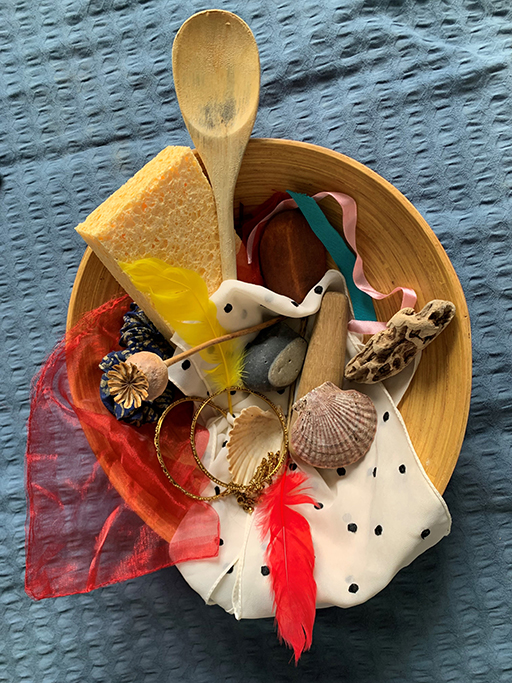3 Treasure Baskets
When babies learn to sit they view the world from a new perspective and they can see things that were previously invisible to them. This is exciting but it can also be frustrating as they notice objects and activities that are out of reach. This is the stage when a Treasure Basket can be helpful, providing scope for exploration in spite of the child’s lack of mobility.
The Treasure Basket concept was inspired by Elinor Goldschmied in the 1980s and 1990s. It is a simple yet profound idea, opposing the trend to give commercial plastic toys to babies by providing them instead with a richer sensory experience. As you have found out in previous weeks, babies learn by actively doing things and engaging in activities with all their senses and limbs. As well as providing space for them to develop their motor abilities, we need to nurture their curiosity. The Treasure Basket was conceived with this in mind, providing objects of various sensory qualities for babies to investigate. In the process of enjoying the activity, babies learn about their world.
The Treasure Basket is made of sturdy wicker, strong enough for a sitting baby to lean an elbow on without flipping the basket. It is approximately fourteen inches across and four or five inches deep. It has straight sides, and is filled with objects of varying tactile qualities for babies to enjoy.
Plastic should be avoided because it offers very little sensory stimulation – even if plastic items vary in size and colour, they still smell, taste, and feel like plastic. In comparison, natural objects provide a wide variety of sensory stimuli, so they offer lots more opportunities. Many everyday household articles also afford a variety of sensory experience and can be popped into the Treasure Basket as well. As a baby shakes or bangs a whisk or a bunch of keys, they notice the sounds it has produced as well as the sensations in their arm and hand. When they pick up a wooden block or a piece of knitted fabric to explore with their fingers, gums and tongue they are exploring texture, colour, scent and flavour. Such actions strengthen cognitive development and motor control.
Activity 18.1 Activity 3 Exploring the possibilities of a Treasure Basket
Take a look at the picture of a Treasure Basket below. Choose three of the items and write down a few ways that a baby might interact with it. Here’s an example for you to follow:
| Feather | Hold it up in the air and drop it to see it fall Stroke it against their cheek or nose to see how it feels Tap the quill on the floor to hear the sound that makes |
| Object | Possible interactions |
Comment
Your answers show just how many opportunities Treasure Baskets provide, and you can have fun finding and choosing items to put in them, then watch the babies scrutinise, squeeze, rub, bang, shake, mouth, drop, and pick them up. Of course, you will need to regularly check for safety and cleanliness of objects as well as replenishing the basket to maintain the babies’ interest. Treasure Baskets are a good example of an ‘engaging experience’ (Welsh Government, 2022, 2023) that provide an opportunity for a child to learn in a hands-on way, at their own pace and using their own interests.
While babies are enjoying the Treasure Basket, the practitioner’s role is often about sitting nearby, quietly observing and enjoying the action but not interfering unless necessary. Babies need opportunities to make their own discoveries, and an adult’s talk or interventions can pose a distraction to their concentration. Your quiet presence will give the children security, and they can always look up to make eye contact or exchange a smile if they wish. They will let you know with body language and other signals when they have had enough, at which point you can put the Treasure Basket away for another day.

